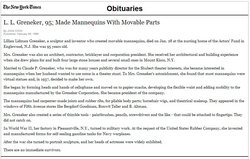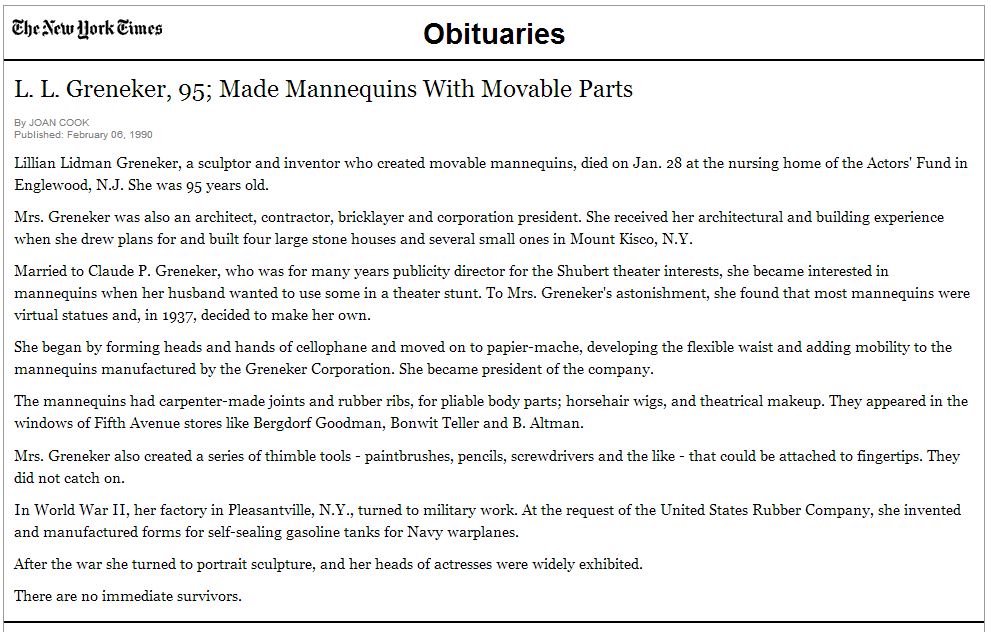Some time in the earlt 30's, CPG consulted LLG about putting her mannequins in the lobby of one of the Shubert theaters, as if they were sculptors. Mannequins were then made of plaster and were extremely heavy. LLG experimented with cellophane and papier maché. The latter material proved highly successful. She founded the Greneker Corporation in 1937 to produce life-like mannequins; and was soon selling them to leading department stores all over the world. Also in the 30s she invented FNG-R-TIP, thimbles that with various attachments can be used to paint, write, erase, manicure, crochet, and so on. During World War II, LLG invented the "Pullcord," a disposable gas tank for warplanes and submarines, and the mannequin factory near Mt. Kisco was converted to defense work for the U.S. Navy.
After the war LLG took up sculpture, creating plaster and bronze portraits of many famous people and copying antiquities in Vatican stone. In 1952 she opened a workshop and gallery in an old stable (the gift of Lee Shubert) on 7th Avenue in New York.
CPG died in 1949. LLG outlived him by 41 years. She continued to improve her FNG-R-TIP invention, and apparently devoted some of this time to writing. She died at the Actors' Fund nursing home, in Englewood, N.J., on Jan. 28, 1990.
____
The Lillian Lidman Greneker Papers are housed at Schlesinger Library, Radcliffe Institute for Advanced Studies at Harvard University. LLG was a noted sculptor and inventor. In 1937, Greneker began making mannequins with moveable parts to replace the plaster statues then in use. Made out of papier mache, the mannequins were manufactured by the Greneker Corporation of Pleasantville, NY. During the Second World War, the company turned to military work and, at the request of United States Rubber Company, she invented and manufactured forms for self-sealing gasoline tanks for Navy warplanes. The collection contains an unpublished autobiography, typescripts of plays, photographs, and other writings.
Some time in the earlt 30's, CPG consulted LLG about putting her mannequins in the lobby of one of the Shubert theaters, as if they were sculptors. Mannequins were then made of plaster and were extremely heavy. LLG experimented with cellophane and papier maché. The latter material proved highly successful. She founded the Greneker Corporation in 1937 to produce life-like mannequins; and was soon selling them to leading department stores all over the world. Also in the 30s she invented FNG-R-TIP, thimbles that with various attachments can be used to paint, write, erase, manicure, crochet, and so on. During World War II, LLG invented the "Pullcord," a disposable gas tank for warplanes and submarines, and the mannequin factory near Mt. Kisco was converted to defense work for the U.S. Navy.
After the war LLG took up sculpture, creating plaster and bronze portraits of many famous people and copying antiquities in Vatican stone. In 1952 she opened a workshop and gallery in an old stable (the gift of Lee Shubert) on 7th Avenue in New York.
CPG died in 1949. LLG outlived him by 41 years. She continued to improve her FNG-R-TIP invention, and apparently devoted some of this time to writing. She died at the Actors' Fund nursing home, in Englewood, N.J., on Jan. 28, 1990.
____
The Lillian Lidman Greneker Papers are housed at Schlesinger Library, Radcliffe Institute for Advanced Studies at Harvard University. LLG was a noted sculptor and inventor. In 1937, Greneker began making mannequins with moveable parts to replace the plaster statues then in use. Made out of papier mache, the mannequins were manufactured by the Greneker Corporation of Pleasantville, NY. During the Second World War, the company turned to military work and, at the request of United States Rubber Company, she invented and manufactured forms for self-sealing gasoline tanks for Navy warplanes. The collection contains an unpublished autobiography, typescripts of plays, photographs, and other writings.
Family Members
Sponsored by Ancestry
Advertisement
Records on Ancestry
Advertisement




